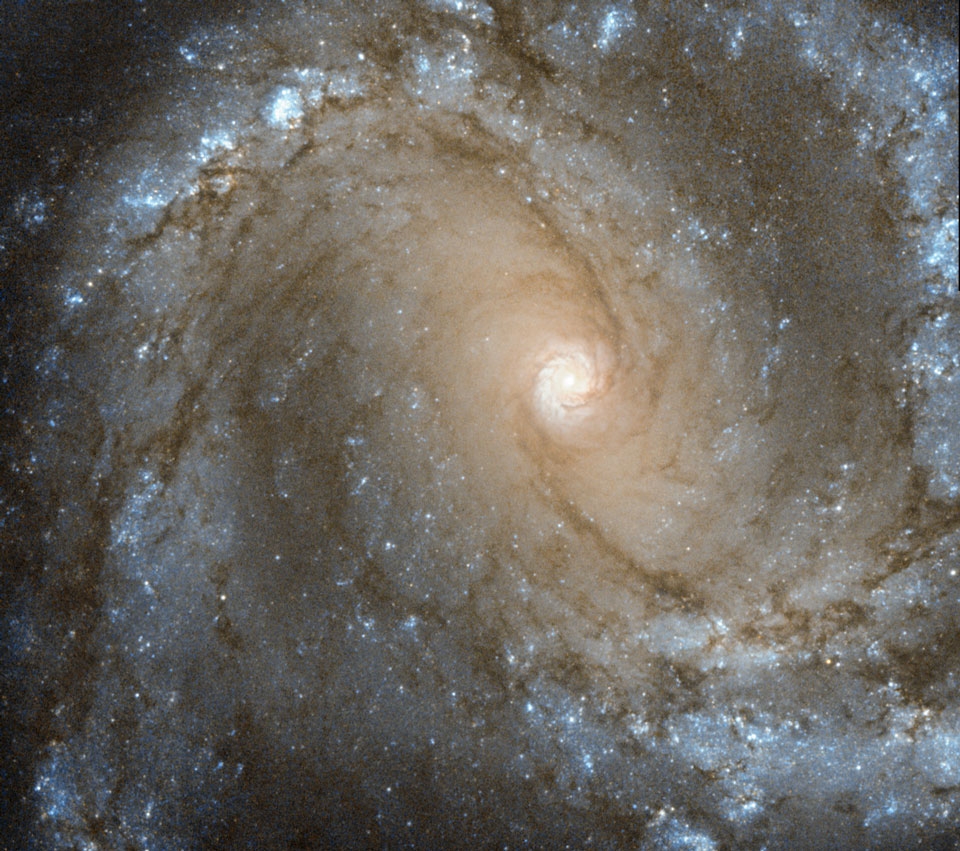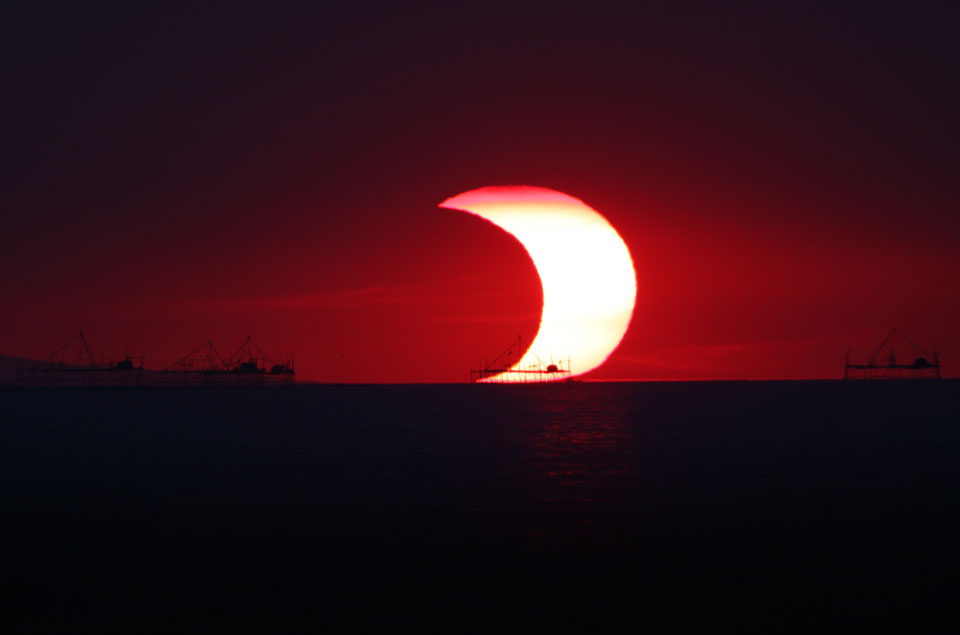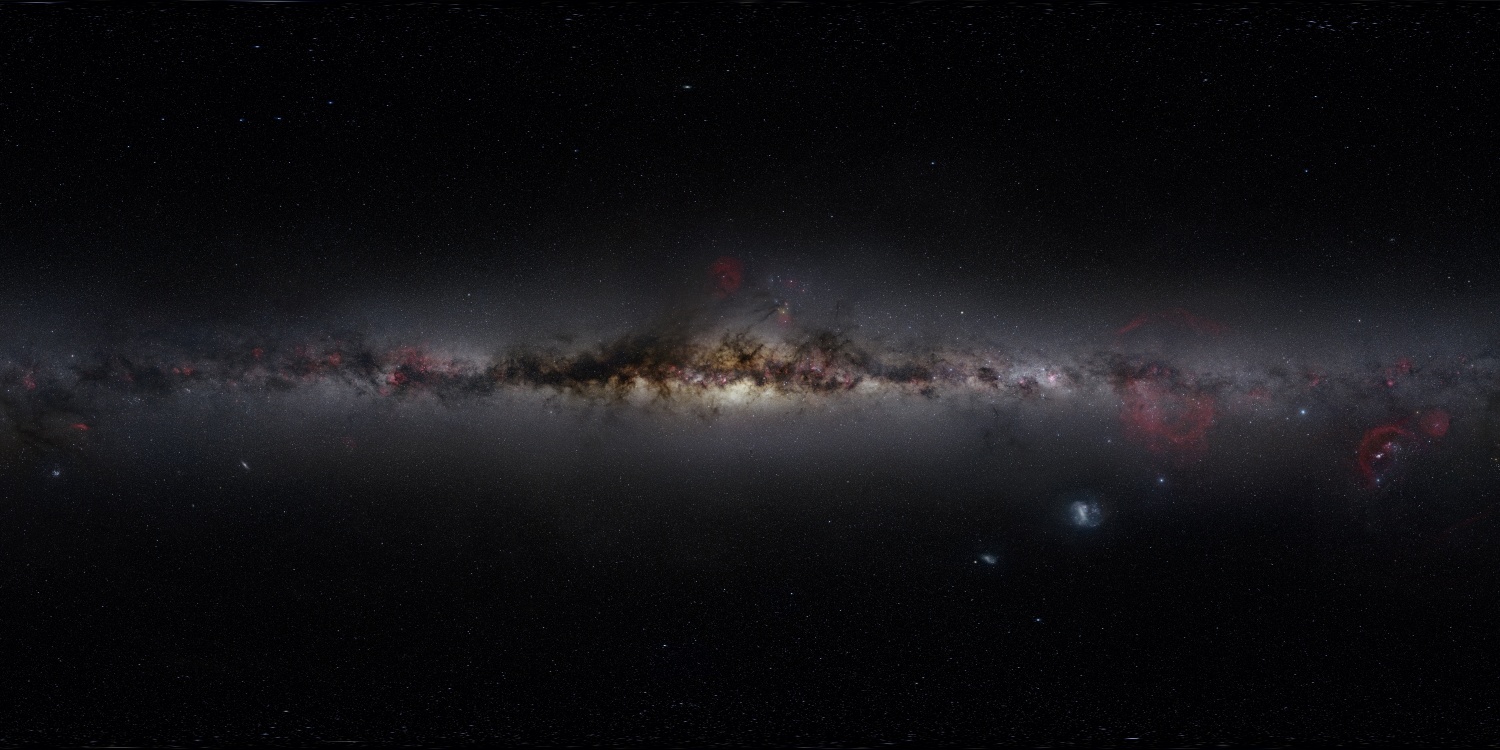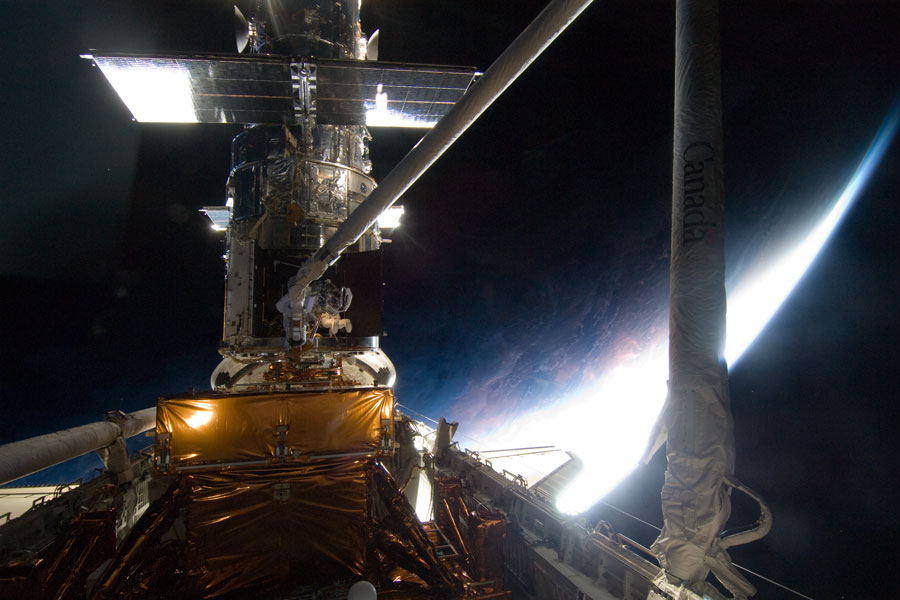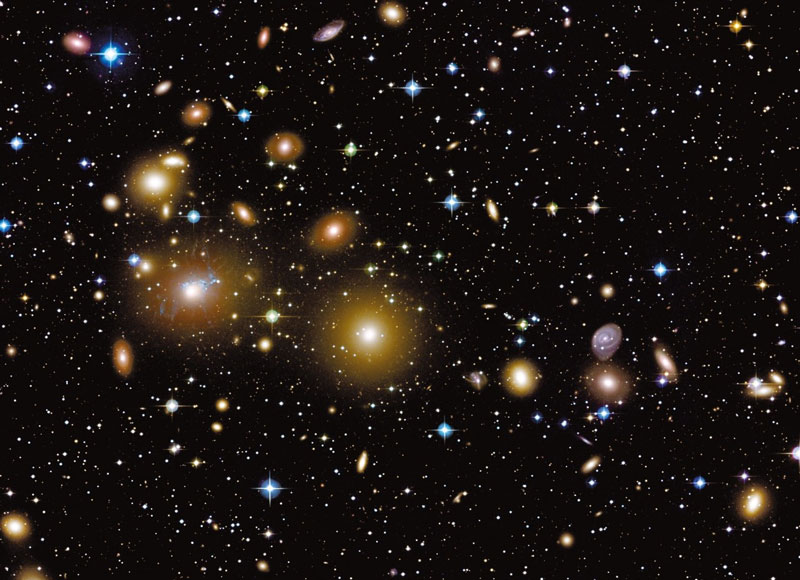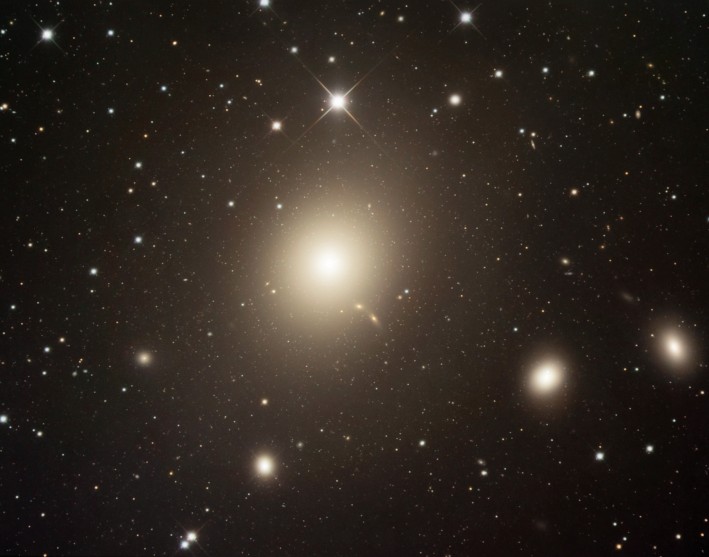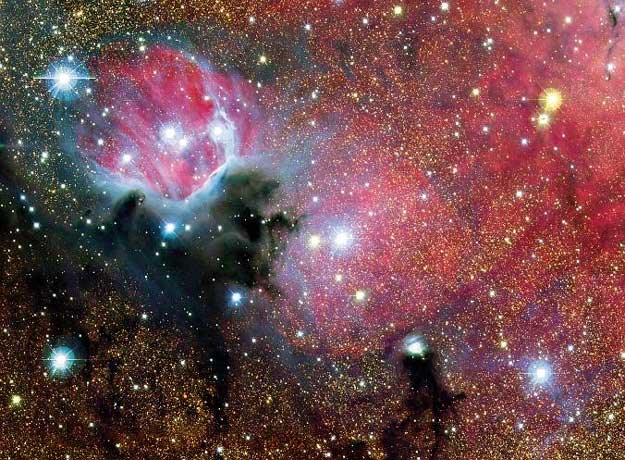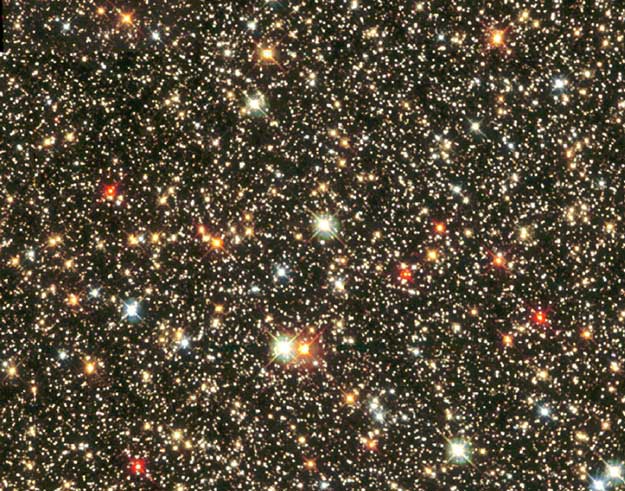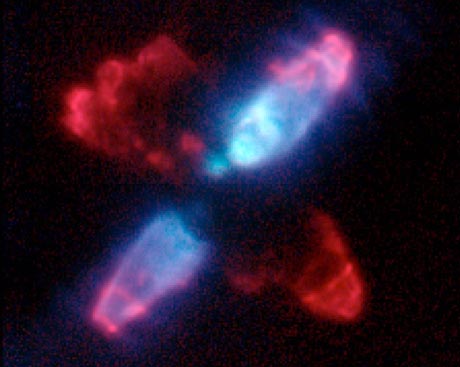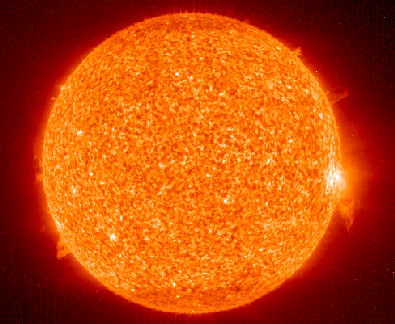| << Previous | Index | Next >> |
2015 What that looming behind this gravel-strewn hill on Comet Churyumov–Gerasimenko? A jagged cliff. The unusual double-lobed nucleus of Comet 67P/Churyumov–Gerasimenko lends itself to unusual and dramatic vistas, another of which has been captured by the Rosetta spacecraft that arrived at the comet last September. The featured cometscape, taken last October and digitally enhanced, spans about 850 meters across. Meanwhile, Comet Churyumov–Gerasimenko continues to sprout jets as it nears its closest approach to the Sun in August. Along the way, Rosetta will continue listening for signals from Philae, a probe that landed on the nucleus but rebounded to an unknown surface location last November. If newly exposed to sunlight, Philae might regain enough energy to again signal Rosetta.
2014 M61 is a barred spiral galaxy located in the nearby Virgo Cluster of Galaxies. Visible in M61 are a host of features common to spiral galaxies: bright spiral arms, a central bar, dust lanes, and bright knots of stars. M61, also known as NGC 4303, in similar to our own Milky Way Galaxy. M61 was discovered by telescope in 1779 twice on the same day, but one observer initially mistook the galaxy for a comet. Light from M61 takes about 55 million years to reach us. The above image of the central regions of M61 was taken with the Hubble Space Telescope and adapted for release as part of the Hubble's Hidden Treasures image processing competition.
2013 Our Sun is not a giant blueberry. Our Sun can be made to appear similar to the diminutive fruit, however, by imaging it in a specific color of extreme violet light called CaK that is emitted by the very slight abundance of ionized Calcium in the Sun's atmosphere, and then false color-inverting the image. This solar depiction is actually scientifically illuminating as a level of the Sun's chromosphere appears quite prominent, showing a crackly textured surface, cool sunspots appearing distinctly bright, and surrounding hot active regions appearing distinctly dark. The Sun is currently near the maximum activity level in its 11 year cycle, and has emitted powerful flares over the past week. During times of high activity, streams of energetic particles from Sun may impact the Earth's magnetosphere and set off spectacular auroras.
2012
2011 Majestic nebulae and stars of our Milky Way Galaxy stretch across this panoramic image of the entire night sky. At full resolution, the 5 gigapixel mosaic was stitched together from over 37,000 images, the result of a season following, year long effort and 60,000 travel miles in search of still dark skies in the American west and the western Cape of South Africa. The well-planned project combined many exposures from the dark sites, intended to produce an inspiring view of the night to rival the brightness of day. An interactive journey through the scene will uncover a congeries of innumerable stars with vast clouds of gas and dust strewn along the galactic plane and central bulge, too faint to see with the unaided eye. Even galaxies of stars beyond our Milky Way can be found within the cosmic vista.
2010 In spiral galaxies, majestic winding arms of young stars, gas, and dust rotate in a flat disk around a bulging galactic nucleus. But elliptical galaxies seem to be simpler. Lacking gas and dust to form new stars, their randomly swarming older stars, give them an ellipsoidal (egg-like) shape. Still, elliptical galaxies can be very large. Centered in this telescopic view and over 120,000 light-years in diameter, larger than our own Milky Way, elliptical galaxy M87 (NGC 4486) is the dominant galaxy of the Virgo Galaxy Cluster. Some 50 million light-years away, M87 is likely home to a supermassive black hole responsible for a high-energy jet of particles emerging from the giant galaxy's central region. In this well-processed image, M87's jet is near the one o'clock position. Other galaxies are also in the field of view, including large Virgo Cluster ellipticals NGC 4478 right of center and NGC 4476 near the right edge.
2009 What is that astronaut doing? Fixing the Hubble Space Telescope. During the fourth servicing mission to upgrade and fix Hubble, astronaut Michael Good can be seen attached to the shuttle's robotic arm, working in an open panel of Hubble. Far below, the terminator between day and night can be seen across planet Earth. Since Hubble was captured by the space shuttle Atlantis last Wednesday, five long space-walks have been used to fix and upgrade the aging telescope. One of the more ambitious orbital missions yet taken, the toiling astronauts have upgraded the Wide Field Camera, fixed the Advanced Camera for Surveys, repaired the Space Telescope Imaging Spectrograph, and replaced COSTAR with the Cosmic Origins Spectrograph. Numerous other general repairs included replacing batteries, gyroscopic sensors, and insulation panels. Hubble will now undergo testing as Atlantis prepares to return to Earth later this week.
2008
2007 How did this spherule come to be on the Moon? When a meteorite strikes the Moon, the energy of the impact melts some of the splattering rock, a fraction of which might cool into tiny glass beads. Many of these glass beads were present in lunar soil samples returned to Earth by the Apollo missions. Pictured above is one such glass spherule that measures only a quarter of a millimeter across. This spherule is particularly interesting because it has been victim to an even smaller impact. A miniature crater is visible on the upper left, surrounded by a fragmented area caused by the shockwaves of the small impact. By dating many of these impacts, astronomers can estimate the history of cratering on our Moon.
2006 In spiral galaxies, majestic winding arms of young stars and interstellar gas and dust rotate in a flat disk around a bulging galactic nucleus. But elliptical galaxies seem to be simpler. Lacking gas and dust to form new stars, their randomly swarming older stars, give them an ellipsoidal (egg-like) shape. Still, elliptical galaxies can be very large. Over 120,000 light-years in diameter (larger than our own Milky Way), elliptical galaxy M87 is the dominant galaxy at the center of the Virgo Galaxy Cluster, some 50 million light-years away. M87 is likely home to a supermassive black hole responsible for the high-energy jet of particles emerging from the giant galaxy's central region.
2005 Early last Sunday morning stars were not the only lights in Iowa skies. The northern lights also shone from the heavens, extending across the midwestern USA and other locations not often graced with auroral displays. The wide-ranging auroral activity was triggered as a coronal mass ejection - an energetic cloud of particles blasted outward from the Sun a few days earlier - collided with planet Earth's magnetosphere. Alerted to conditions ripe for aurora, photographer Stan Richard recorded this aparition over Saylorville Lake, near Des Moines. Bright planet Mars in the constellation Aquarius is above the horizon near the center of the eastward-looking view. While the colorful rays seem to end just above the water, they are actually at altitudes of 100 kilometers or more.
2004 Three young, massive stars will eventually emerge from this natal cloud of dust and gas, but their presence is already revealed in this false-color image from the Spitzer Space Telescope. The picture offers a penetrating infrared view of an emission nebula cataloged as Sharpless 140 which lies about 3,000 light-years away toward the constellation Cepheus. The young stars are otherwise obscured in visible light images by the dusty environs. Sculpted by winds and radiation from hot stars in the region, the majestic arcing structures pictured here are tens of light-years across and contain surprisingly complex molecules - polycyclic aromatic hydrocarbons (PAHs) - that glow in the infrared. An amazingly detailed record of cosmic markers of star formation, the image hints at the wealth of infrared data now freely available in the Spitzer Space Telescope archive.
2003 What did the first quasars look like? The nearest quasars are now known to be supermassive black holes in the centers of galaxies. Gas and dust that falls toward a quasar glows brightly, sometimes outglowing the entire home galaxy. The quasars that formed in the first billion years of the universe are more mysterious, though, with even the nature of the surrounding gas still unknown. Above, an artist's impression shows a primordial quasar as it might have been, surrounded by sheets of gas, dust, stars, and early star clusters. Exacting observations of three distant quasars now indicate emission of very specific colors of the element iron. These Hubble Space Telescope observations, which bolster recent results from the WMAP mission, indicate that a whole complete cycle of stars was born, created this iron, and died within the first few hundred million years of the universe.
2002 To the east of the Lagoon Nebula is a star field rich in diversity. On the lower left are clouds rich in dark dust that hide background stars and young star systems still forming. Dark clouds include LDN 227 on the left and IC 1275 on the right, with a bright star near its tip. On the upper right are clouds rich in hot glowing gas, including part of the emission nebula NGC 6559. On the right, between the two regions, is a nebula reflecting light from a group of massive blue stars. The NGC 6559 complex pictured above spans about 3 light years and likely has a common history with the Lagoon Nebula. The complex lies about 5000 light-years away toward the constellation of Sagittarius.
2001 Stars come in all different colors. The color of a star indicates its surface temperature, an important property used to assign each star a spectral type. Most stars in the above Sagittarius Star Cloud are orange or red and relatively faint, as our Sun would appear. The blue and greenish stars are hotter, many being relatively young and massive. The bright red stars are cool Red Giants, bloated stars once similar to our Sun that have entered a more advanced stage of evolution. Stars of this Sagittarius Cloud lie towards the center of our Galaxy - tantalizing cosmic jewels viewed through a rift in the dark, pervasive, interstellar dust. This famous stellar grouping houses some of the oldest stars known.
2000 Arcing toward a fiery fate, this Sungrazer comet was recorded by the SOHO spacecraft's Large Angle Spectrometric COronagraph (LASCO) on Dec. 23rd, 1996. LASCO uses an occulting disk, partially visible at the lower right, to block out the otherwise overwhelming solar disk allowing it to image the inner 5 million miles of the relatively faint corona. The comet is seen as its coma enters the bright equatorial solar wind region (oriented vertically). Spots and blemishes on the image are background stars and camera streaks caused by charged particles. Positioned in space to continuously observe the Sun, SOHO has detected 7 sungrazing comets. Based on their orbits, they are believed to belong to a family of comets created by successive break ups from a single large parent comet which passed very near the sun in the twelfth century. The bright comet of 1965, Ikeya-Seki, was also a member of the Sungrazer family, coming within about 400,000 miles of the Sun's surface. Passing so close to the Sun, Sungrazers are subjected to destructive tidal forces along with intense solar heat. This comet, known as SOHO 6, did not survive.
1999 Late last month a team of Mars-watching astronomers sighted an immense cyclonic storm system raging near the Red Planet's north pole. Their discovery picture, made with the Hubble Space Telescope on April 27, is seen at left while the projected insets (right) show closeups of the storm and surrounding areas. Shrunken to its martian midsummer state, Mars' north polar cap appears at the top of the discovery picture. The polar cap is clearly smaller than the storm just below it and farther left. Similar to the "spiral storms" detected on Mars over 20 years ago by the Viking spacecraft, this storm was marked by a system of swirling bright water-ice clouds instead of the billowing dust of a more typical martian wind storm. Measuring roughly 1,000 miles across, with a cloud-free central eye spanning about 200 miles, it was comparable in size to cyclones seen in planet Earth's polar regions. The storm system was imaged once more, hours later, but then was not seen again and may have had a lifetime of only a few days.
1998 Staring at the Sun from a vantage point in space (Kids, don't try this at home!), the Solar and Heliospheric Observatory (SOHO) has enabled the discovery of much about our closest star. It has also been used to discover about 50 comets. While not competing with Hale-Bopp, one of SOHO's recently discovered comets has proved to be bright enough to see with the unaided eye. The May 4th discovery image is shown above with an enlarged inset of the comet. This colorized image is from SOHO's solar coronagraph (LASCO) which views the region around the Sun by blocking out the overwhelming sunlight with an occulting disk. The disk is visible near the bottom left, with the Sun's size and position indicated by the white circle. Bright solar wind regions can also be seen along with the the planet Mars and a background of stars. The comet itself is just entering the field of view at the upper right. Observers report that Comet SOHO (1998 J1) has now been seen low in the western sky following sunset and is moving south and east becoming more visible as this month progresses, particularly from the Southern Hemisphere.
1997 The Egg Nebula is taking a beating. Like a baby chick pecking its way out of an egg, the star in the center of the Egg Nebula is casting away shells of gas and dust as it slowly transforms itself into a white dwarf star. The above picture was taken by the newly installed Near Infrared Camera and Multi-Object Spectrometer (NICMOS) now on board the Hubble Space Telescope. A thick torus of dust now surrounds the star through which the shell gas is escaping. Newly expelled gas shells escape in beams as can be seen in the original HST image and in the recently released image shown above. This infrared image is coded in false color to highlight two different types of emission. The red light represents hot hydrogen gas heated by the collisions of expanding shells. The blue light represents light from the central star scattered by the dust in the nebula. It takes light about 3000 years to reach us from the Egg Nebula, which is hundreds of times the size of our Solar System.
1996 Above is an image of the relatively quiet Sun made on May 18 in light emitted by ionized Helium atoms in the Solar chromosphere. Helium was first discovered in the Sun in 1868, its name fittingly derived from from the Greek word Helios, meaning Sun. Credit for the discovery goes to astronomer Joseph Lockyer. Lockyer relied on a recently developed technique of spectroscopy, dissecting sunlight into a spectrum, and the idea that each element produces a characteristic spectral pattern of bright lines. He noticed a yellow line in a solar spectrum made during an eclipse which could not be accounted for by elements known on Earth. Almost 27 years later Helium was finally discovered on Earth when the spectrum of a Helium bearing mineral of Uranium provided an exact match to the previously detected element of the Sun. Helium is now known to be the second most abundant element (after Hydrogen) in the Universe.
| << Previous | Index | Next >> |

